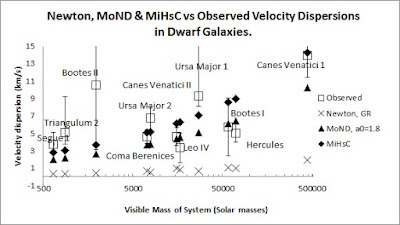I've written a lot about why MiHsC is infinitely better than the ad hoc addition of dark matter to galaxies to make their spin agree with general relativity. There is also the empirical theory of MoND (Modified Newtonian Dynamics) which was invented by Mordehai Milgrom, in 1983. MoND is far less arbitrary than dark matter, and it fits disc galaxy rotations by empirically changing the dynamical laws at their edges. Much as I admired MoND, and it inspired me to develop MiHsC, I'd like to explain why MiHsC is much better because it doesn't need an adjustable parameter. This explanation may seem basic and obvious, but I do believe that this crucial advantage of MiHsC has not been appreciated.
Imagine you have some data in a rough line on a graph (see the crosses on the graph) that you want to explain or model. As we know we can fit a straight line through them using the formula y=mx+b where x is the horizontal co-ordinate, y is the vertical co-ordinate, m is the slope of the line and b is the offset (changing the value of b allows us to shift the line up and down to fit the data (see the red lines on the graph). Now imagine you vary b again and again (the various red lines) until the line is aligned with the data and then you choose that line (say y=mx+a0) as the correct model. Would you go around enthusing about the great theory you have? No. It predicts the data, sure, but this is not so surprising because you chose the arbitrary value of a0 to make it so. I hate criticising MoND because its so much better than dark matter and at the time it was a bold and justified attack on the standard theory, and highlighted the odd number a0, but it works like the example above, because MoND has an arbitrary constant called a0 that is set completely arbitrarily to fit the galaxy rotation data. The a0 is the same for each galaxy, true, but there is no reason given why it should be that value (usually a0=2x10^-10 m/s^2).
Now imagine a theory based on a mechanism that can only predict that y=mx+c (as a simple example) where c is the speed of light (a number which is solidly known and unfudgable) and this theory happens to fits the data first time (the blue line in the graph). This is infinitely better because no arbitrary human input is required. This then is like MiHsC, which does everything that MoND does but without the adjustable parameter. MiHsC's predictions are slightly different to MoND's. For example, MiHsC performs better for huge galaxy clusters and tiny dwarfs whereas MoND was 'tuned' with a0 for intermediate sized systems so does better for those, but both are within the uncertainty in the data, so far. Hopefully though you can see that MoND is not a theory (it's an empirical relation with an unexplained tuning parameter) whereas MiHsC is a theory and its inevitable agreement is a great advantage.
References
McCulloch, M.E., 2012. Testing quantised inertia on galactic scales. A&SS, 342, 2, 575-578. Preprint: http://arxiv.org/abs/1207.7007


